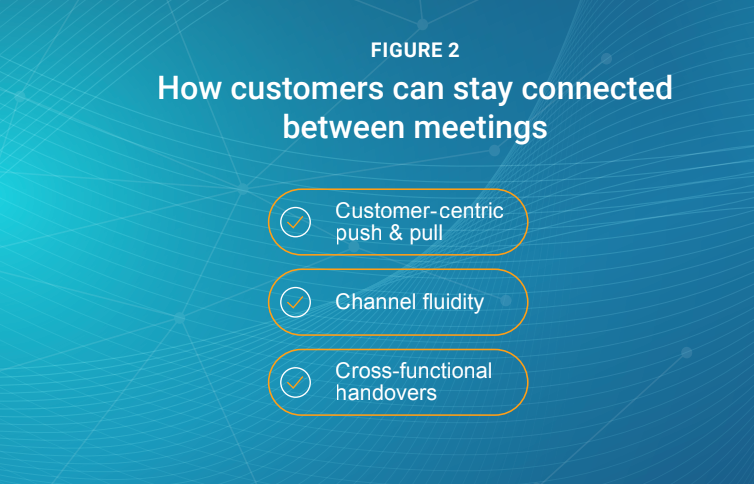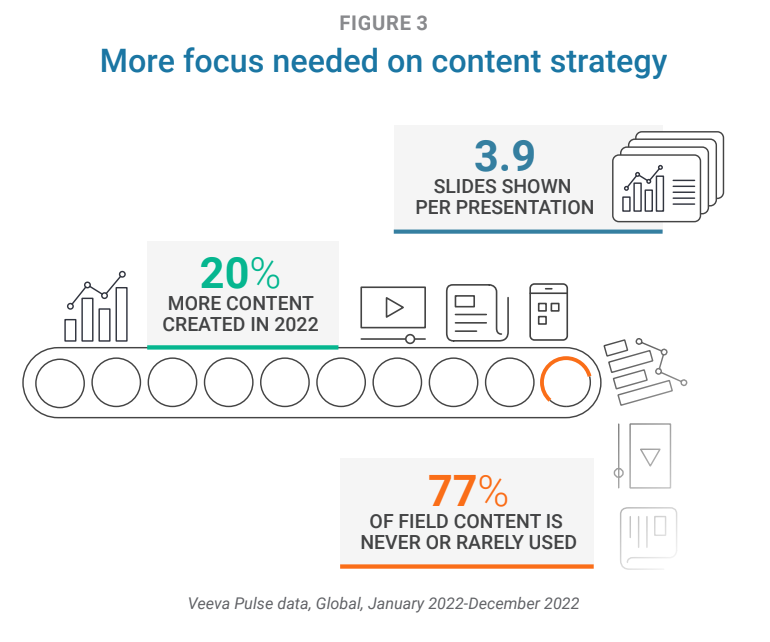eBook
Biopharma's Connected Customer:
Reinforcing Commercial Excellence
To remain customer-centric, biopharma companies need to think of HCPs as connected customers – so they can engage teams on their terms.
The rise of specialty medicine has led to more product launches, decision-makers and influencers, and diversity in go-to-market models for biopharma companies to navigate. In this complex environment, many in the sector strive for customer centricity by focusing on role coordination, channel strategy, and ensuring field compliance.
But one blind spot is that healthcare professionals (HCPs) increasingly want to stay in touch with field teams and medical science liaisons (MSLs) between scheduled meetings. These HCPs need to connect with teams at short notice so they can gather information for their patients — who, in turn, are influenced by publicly-available sources, as well as interactions with nurses, caregivers, key opinion leaders (KOLs), community leaders, and payers [Figure 1].
It’s challenging to provide an excellent customer experience without recognizing the impact of these new dynamics and diverse stakeholders. Your company may already offer a wide range of relevant engagement channels to HCPs, but in practice, few can engage with biopharma organizations when and how they want. This leaves them reliant on their field contact to find the right experts, even though direct communication through ‘pull’ channels would be quicker and easier. Your teams can add value at key moments by facilitating channel choice and organizing resources efficiently around HCPs [Figure 2].

Connected customers need connected teams
When HCPs are treated as connected customers, they can engage your commercial and medical teams when their patients need them to, rather than waiting for field teams to coordinate a meeting on their behalf.
Dr. Jesús San-Miguel is a professor of hematology and director of clinical and translational medicine at the University of Navarra in Spain. As a principal investigator, his colleagues often approach him with clinical questions on newly-approved drugs (including side effects and dose modification) that the biopharma company responsible for drug development is better positioned to answer. He explains, “This suggests that the toxicology department of the pharma company could be closer to physicians, so they know who to contact for these topics.”
Pull channels enable HCPs to stay connected to your commercial and medical organizations between meetings. That way, they can schedule calls or send a quick message as questions arise. The result is higher-value engagement: as leading oncology companies relying on video and using content have found, scheduled meetings last significantly longer (47 minutes vs. 28 minutes). 1
Coalesce the right resources around HCPs
HCPs often interact with several teams within the same organization. They require resources and expertise to be efficiently organized around their needs, irrespective of function: commercial, key account management (KAM), marketing, or medical.
Sales, medical, and marketing must collaborate closely for this to happen. When sales and marketing work together in lockstep, HCPs benefit from better access to your organization’s expertise: we know that field teams that share digital content during meetings with HCPs drive 2.5 times more new patient starts than calls that don’t share content.

Closer collaboration has a multiplier effect: teams acting together strengthen the customer relationship more than each function alone. Yet some cross-functional misalignment persists today. Only 39% of meetings globally shared content last year [Figure 3]. And 77% of content assets were rarely or never used, perhaps due to a lack of training or confusion over which content is most effective.2 Eliminating unused content would free up resources for training and creating higher-impact content that resonates with HCPs.
Beyond sharing relevant content, meetings add significant value when the right people are around the table. Although physicians sometimes meet with several members of the same company, Dr. San-Miguel notes: “A more inclusive format than a one-to-one meeting would be for the MSL and sales rep to meet with all doctors working on the same subspecialty in the same department. This would maximize the meeting’s usefulness when discussing a drug.”

HCPs in control of channel choice
Channel fluidity means that the HCP decides how to engage with your organization based on their specific request and what’s most convenient that day [Figure 4]. True choice of channel is only feasible when your teams and HCPs use the same platform. An HCP might want to schedule a quick in-person (or group) meeting to review content with a field contact. More urgent questions could be resolved through two-way chat or SMS — and given the increased regulatory scrutiny of instant messaging, both sides will need a compliant alternative to consumer-grade apps.
Medical inquiries are often addressed most effectively through a remote call, so when an HCP requires information from an MSL, they should be able to contact them and schedule a meeting directly. The easiest way to undertake something complicated, like requesting a sample, could be through an engagement platform.
Always connected means never missing an opportunity
What are the best ways to reinforce commercial excellence within your organization? Leading companies are advancing in the following areas:
- Providing a real-time service for HCPs
- HCPs choose when, how, and whom to engage
- All functions use the same platform as HCPs
- Compliant chat for quick requests
Communication must be a two-way street to stay close to customers in a complex environment. Effective companies ensure that HCPs can take charge of the dialogue, creating value at the moments that matter to their patients.
About Veeva Systems
Veeva is the global leader in cloud software for the life sciences industry. Committed to innovation, product excellence, and customer success, Veeva serves more than 1,000 customers, ranging from the world’s largest biopharmaceutical companies to emerging biotechs. As a Public Benefit Corporation, Veeva is committed to balancing the interests of all stakeholders, including customers, employees, shareholders, and the industries it serves. For more information, visit veeva.com/eu.
Register to attend Veeva Commercial Summit, Europe, and learn how leading companies are reinforcing commercial effectiveness.
1, 2Veeva Pulse Field Trends Report
